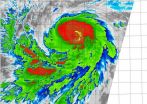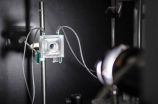(Press-News.org) Tropical Storm Erika was centered in the Eastern Caribbean Sea and affecting Puerto Rico and Hispaniola when NASA's Terra satellite passed overhead mid-day on Friday, August 28, 2015. Two hours after Terra passed, NOAA's GOES-East satellite saw Erika's western side over the Dominican Republic.
At 15:05 UTC (11:05 a.m. EDT) the Moderate Resolution Imaging Spectroradiometer instrument aboard NASA's Terra satellite captured a visible light image Tropical Storm Erika approaching Hispaniola. Erika's center was in the eastern Caribbean Sea, and the northern quadrant of the storm blanketed Puerto Rico with clouds and showers.
Just two hours later NOAA's GOES-East satellite captured a visible image of Erika and showed that the storm had already covered the Dominican Republic on its west-northwestern track.
Watches and Warnings
At 2 p.m. EDT, there were a number of watches and warnings still in effect for the Eastern Caribbean and the Bahamas. A Tropical Storm Warning was in effect for the Dominican Republic, Haiti, southeastern Bahamas, Turks and Caicos Islands, and the central Bahamas. A Tropical Storm Watch was in effect for the northwestern Bahamas, the Cuban Provinces of Ciego de Avila, Camaguey, Las Tunas, Holguin, and Guantanamo.
Heavy rainfall is a large threat from Erika. Erika is expected to produce total rainfall accumulations of 3 to 6 inches with maximum amounts of 10 inches possible across portions of the Dominican Republic and Haiti, the Turks and Caicos Islands, and the southeastern and central Bahamas through Saturday. An additional 1 to 2 inches is expected for Puerto Rico. These rains could cause life-threatening flash floods and mud slides.
Erika on August 28, 2015 at 2 p.m. EDT
At 2 p.m. EDT (1800 UTC) on August 28, 2015, the center of Tropical Storm Erika was located near latitude 17.7 North, longitude 70.2 West. Punta Cana at the eastern end of the Dominican Republic reported wind gusts of 40 mph (64 kph).
Erika has been moving westward near 18 mph (30 km/h) for the past several hours. A motion toward the west-northwest is expected to being later this afternoon or tonight and continue through Sunday, August 30. On the forecast track, the center of Erika will move near the Turks and Caicos Islands on Friday night, August 28 and move near the central and northwestern Bahamas on August 29.
Maximum sustained winds are near 50 mph (85 kph) and some weakening is forecast from the National Hurricane Center as Erika moves over land. The minimum central pressure based on Hurricane Hunter aircraft data and surface observations is 1009 millibars.
Factors to Consider in Erika's Fate
The NHC is closely monitoring the storm and adjusting the forecast track as needed. There are a number of factors that are being considered in the National Hurricane Center (NHC) forecast. NHC Forecaster Beven noted in the Aug. 28 NHC discussion at 2 p.m. EDT, "Westerly to southwesterly vertical wind shear is forecast to continue or increase during the next 12 to 24 hours. This, combined with land interaction, suggests that the cyclone should weaken, and there is a chance the system could degenerate to a tropical wave while crossing Hispaniola. Assuming the cyclone survives, the shear should decrease some after 36 hours, which could allow some strengthening up to the time of possible landfall on the Florida Peninsula."
As of 2 p.m. EDT on August 28, the NHC five day forecast track takes Erika on a track northwest and paralleling the north coast of Cuba before making landfall in southwestern Florida early Monday, August 31. To get the latest forecast, watches, warnings and storm track, visit the NHC website: http://www.nhc.noaa.gov.
INFORMATION:
To understand how confidence in parenting may predict parenting behaviors in women who were abused as children, psychologists at the University of Rochester have found that mothers who experienced more types of maltreatment as children are more critical of their ability to parent successfully. Intervention programs for moms at-risk, therefore, should focus on bolstering mothers' self-confidence--not just teach parenting skills, the researchers said.
"We know that maltreated children can have really low self-esteem," said Louisa Michl, a doctoral student in the department ...
A simple change in the wording of a traffic sign - from "Share the Road" to "Bicycles May Use Full Lane" - could help clarify the rules of the road for bicyclists and motorists, according to a North Carolina State University study.
"'Share the Road' signs are common but what that means in terms of how drivers and bicycle riders should interact can be ambiguous," says George Hess, natural resources professor and co-author of the study in PLOS One. Some bicyclists complain that motorists consider them to be in the way, while some motorists accuse bicyclists of hogging ...
Consider the pendulum of a grandfather clock. If you forget to wind it, you will eventually find the pendulum at rest, unmoving. However, this simple observation is only valid at the level of classical physics--the laws and principles that appear to explain the physics of relatively large objects at human scale. However, quantum mechanics, the underlying physical rules that govern the fundamental behavior of matter and light at the atomic scale, state that nothing can quite be completely at rest.
For the first time, a team of Caltech researchers and collaborators has ...
Washington DC - August 28, 2015 - Oysters not only transmit human norovirus; they also serve as a major reservoir for these pathogens, according to research published August 28 in Applied and Environmental Microbiology, a journal of the American Society for Microbiology. "More than 80 percent of human norovirus genotypes were detected in oyster samples or oyster-related outbreaks," said corresponding author Yongjie Wang, PhD.
"The results highlight oysters' important role in the persistence of norovirus in the environment, and its transmission to humans, and they demonstrate ...
NASA-NOAA's Suomi NPP satellite flew over Hurricane Jimena in the Eastern Pacific and saw the strongest thunderstorms building up quickly, especially in the northern quadrant of the storm. Jimena intensified rapidly overnight on August 27 and early August 28 and the National Hurricane Center expects it to become a major hurricane.
The Visible Infrared Imaging Radiometer Suite or VIIRS instrument aboard the satellite provided infrared data of the storm that showed the coldest cloud top temperatures, which indicate the strongest thunderstorms were in Jimena's northern ...
Generating and storing renewable energy, such as solar or wind power, is a key barrier to a clean-energy economy. When the Joint Center for Artificial Photosynthesis (JCAP) was established at Caltech and its partnering institutions in 2010, the U.S. Department of Energy (DOE) Energy Innovation Hub had one main goal: a cost-effective method of producing fuels using only sunlight, water, and carbon dioxide, mimicking the natural process of photosynthesis in plants and storing energy in the form of chemical fuels for use on demand. Over the past five years, researchers at ...
If you think that performing CPR on a person whose heart has stopped is a surefire way to save their life, you may be watching too much TV.
The truth is more depressing than fiction, according to a new study by University of Southern California Davis School of Gerontology researchers. While medical dramas Grey's Anatomy and House show cardiopulmonary resuscitation saving a patient's life nearly 70 percent of the time, the real immediate survival rate is nearly half that - around 37 percent.
Researchers also found another discrepancy between reality and TV: Half of ...
TAMPA, Fla. - Pancreatic cancer is the fourth most common cause of cancer-related death in the United States and has a 5-year survival rate of only 6 percent, which is the lowest rate of all types of cancer according to the American Cancer Society. This low survival rate is partially attributed to the difficulty in detecting pancreatic cancer at an early stage. According to a new 'proof of principle' study published in Aug. 27 issue of Cancer Prevention Research, Moffitt Cancer Center researchers hope to improve pancreatic cancer survival rates by identifying markers in ...
Beach sand contains all kinds of microorganisms, including those that can harm human health. Yet current guidelines are focused exclusively on monitoring the levels of microbes in the water.
Now, an international panel of scientists is recommending monitoring the sand at recreational beaches, to minimize health risks for beachgoers. Their advice is based on the general consensus reached during the international conference "Trends in Environmental Microbiology and Public Health," held in Lisbon Portugal in September 2014.
"Beach sands accumulate contaminants and people ...
A collaboration between biologists and engineers at Monash University has led to the development of a new non-invasive image processing technique to visualise embryo formation. Researchers were able to see, for the first time, the movement of all of the cells in living mammalian embryos as they develop under the microscope. This breakthrough has important implications for IVF (in vitro fertilisation) treatments and pre-implantation genetic diagnosis (PGD). In the future, this approach could help with embryo selection before the embryo is implanted back into the uterus to ...



